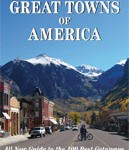The Power of a Great Town
Intro by Julie Burgmeier Article by Roger Brooks
Population about 800, La Conner Washington’s main industry is tourism along with agriculture and fisheries. There are only 2 streets with commercial properties and no stoplights or speed limits over 25. La Conner is on the Swinomish Channel which leads to the San Juan Islands, surrounded by intensely beautiful farmlands, has a soul derived from culture and art, and has a diverse heritage including pioneers, swinomish Native Americans, loggers, fishermen, farmers, and artists. I have been volunteering for the La Conner Chamber of Commerce for the past 4 years. We have come along way in our marketing strategies, and we are now moving into product development. I had this email sent out to the business community, and I have had several requests for a re-send. Here ya go!
1:The heart and soul of every community, besides its people, is its downtown. The health of a community can instantly be portrayed by the vitality of its downtown. It is the litmus test for all your economic development efforts – both tourism and non-tourism. Downtown provides that all-important first impression of the community that answers the questions: “Is this a place I’d want to live? A place my employees would want to live? A place I’d want to hang out? Show off to friends and relatives?” If you want people to visit your community, to open or relocate a business there, or move to your town, downtown needs to be a place they’d enjoy spending time in.
2. The number one activity of visitors throughout the world is shopping, dining and entertainment in a pedestrian friendly setting. It’s typically not the reason we go to a destination, but it is the top diversionary activity of visitors once they’re there.
3. Consider this: The average visitor is active 14 hours a day, yet they only spend four to six hours with the primary activity that brought them there. Then they spend eight to ten hours with diversionary, or secondary activities. Diversionary activities are things they could do closer to home but will do while in town. As an example, Branson, Missouri hosts 7.5 million visitors a year, and the average visitor will see one or two shows a day, totaling approximately four hours. The 49 theaters are what brings them to town (the primary lure), but once there, they spend the rest of their time shopping, dining, at theme parks and attractions, or on recreational pursuits: hiking, biking, boating, fishing, golf, etc.
4. Here’s the amazing statistic: Secondary activities are where 80% of all visitor spending takes place. It’s ok to be a “diversionary” activity. When we’re out fishing or hiking or biking, we are not spending money. When we are competing in a sports game, we are not spending money. But when we’re done, guess what? We’re off looking for the nearest watering hole, great shops, restaurants, and entertainment. Why did Disney build Downtown Disney outside of Disney World? To capture that other 80% of visitor spending. Smart move.
5. Curb appeal can account for 70% of visitor sales at restaurants, golf courses, wineries, retail shops, and lodging facilities. Amazing isn’t it? You could spend millions of marketing dollars to pull people into your community, but none of that will make a visitor walk into a restaurant or retail shop and say, “Here’s my credit card.” The merchant must do that. It’s that old adage of “you can lead a horse to water, but you can’t make him drink.” Many merchants have no idea how to pull customers in the door by presenting a beautiful, welcoming entry with planters, benches, attractive signage and window displays. We all travel. Have you ever uttered these words: “That looks like a nice place to eat.” Other than asking a local, or finding where the most local pickup trucks are parked, this is our only other clue to help make a decision.
6. If local residents do not hang out in your downtown, neither will visitors. Visitors are not looking for “best kept secrets” or “solitude” when downtown. They are looking for places where other people go. They want to be in a lively, thriving environment. If downtown has the activities and attractions to draw residents, visitors will want to go there too. The number one reason people travel is to visit friends and relatives. When they visit you, where do you take them? That’s what I thought.
7. Then there’s the 10+10+10 rule or the “Rule of Critical Mass.” After researching 400 towns and downtown districts in the U.S. and Canada, we found the minimum critical mass it takes to make downtown a destination. In just three lineal blocks (not square blocks) you must have a minimum of ten places that serve food: soda fountain, bistro, café, bakery, confectionary, sit-down restaurant, coffee shop, to name a few. The second ten are destination retail shops. These are NOT big box and chain stores, but ten specialty shops. These might include galleries, clothing, outfitters, artisans in action, wine shops, books, antiques (not second hand stores), home accents, gardening and gourmet cooking stores. And the third ten: Places open after 6:00, preferably entertainment.
8. And that brings us to today’s most important and amazing statistic. A full 70% of all consumer spending (locals and visitors alike) takes place after 6:00 pm. Are you open? And you wonder why downtowns are dying while lifestyle retail centers are thriving. For you in the tourism industry, consider this: people spend the night where there are things to do after 6:00. Not just dining, but also shopping, activities or entertainment. Few people, particularly leisure travelers, want to be holed up in a hotel room twiddling their thumbs watching reruns of Fear Factor. These few statistics are why more and more Destination Marketing Organizations are now being forced to step out of the comfort zone of focusing all their efforts on marketing, and into the realm of product development. After all, a good product sells itself, and many downtowns need work to become a good product. Tourism and downtown professionals should be joined at the hip. Get cozy.




Leave a Reply
Want to join the discussion?Feel free to contribute!